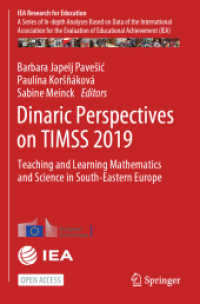- ホーム
- > 洋書
- > 英文書
- > Science / Mathematics
基本説明
State-of-the-art theory behind MIMO techniques with solid practical guidance for engineers on how to implement the techniques in compliance with the standard.
Full Description
Foreword from Arogyaswami Paulraj, Professor (Emeritus), Stanford University (USA)
Contents
ForewordPrefaceAbout the Editors, Authors and ContributorsIntroductionPart I MIMO FundamentalsChapter 1 A Short Introduction to MIMO Information Theory1.1 The Shannon-Wiener Legacy: From 1948 to 20081.2 Preliminaries1.3 Information Theoretic Aspects1.4 Signal Processing Aspects1.5 Wiener vs. Shannon: An Ever Closer UnionChapter 2 MIMO Propagation and Channel Modeling2.1 Introduction2.2 Model Classification2.3 Parameters of the MIMO Radio Channel2.4 CSI and Channel Randomness2.5 What Kind of Correlation in MIMO?2.6 MIMO Measurements2.7 What Makes a Good Channel Model?2.8 Examples of MIMO Radio Channel Models2.9 Some ConclusionsAcknowledgmentChapter 3 Space Time Codes and MIMO Transmission3.1 Introduction3.2 Diversity and Multiplexing Gain3.3 Theory of Space-time Coding3.4 Space-time Code3.5 Spatial Multiplexing3.6 Precoding3.7 MIMO in Current and Emerging Standards3.8 SummaryChapter 4 Interference Functions - A Mathematical Framework for MIMO Interference Networks4.1 Multiuser Channels4.2 A General Framework for Optimizing Interference Networks4.3 Joint Interference Mitigation and Resource Allocation4.4 Implementation AspectsPart II ImplementationChapter 5 Advanced Transmitter and Receiver Design5.1 Introduction5.2 Turbo Equalization5.3 Turbo Equalization on Frequency-Selective MIMO Channels5.4 Turbo Synchronization5.5 Turbo Synchronization on Frequency-Selective MIMO ChannelsChapter 6 Implementing Scalable List Detectors for MIMO-SDM in LTE6.1 Introduction6.2 Radius-Based Detector Algorithm6.3 Mapping of the Radius-Based Detector6.4 SSFE Detector6.5 ConclusionsChapter 7 IEEE 802.11n Implementation7.1 IEEE 802.11n PHY Layer Introduction7.2 IEEE 802.11n Transmitter Part7.3 IEEE 802.11n Receiver Part7.4 Simulation Results7.5 ConclusionChapter 8 WiMAX Implementation8.1 Introduction8.2 Existing Schemes in IEEE 802.16e8.3 MIMO Candidates for IEEE 802.16m8.4 UL-MIMO Schemes in WiMAX Systems8.5 Cyclic Delay Diversity (CDD)8.6 Tile-Switched Diversity (TSD)8.7 Performance8.8 Potential Impacts on Architecture8.9 ConclusionsChapter 9 LTE and LTE-Advanced9.1 Transmission Structure9.1.1 LTE Downlink9.1.2 LTE Uplink9.2 LTE MIMO Schemes9.3 LTE-Advanced MIMO SchemesChapter 10 Multiple Antenna Terminals10.1 Size-Performance Trade Off10.2 Performance of Compact Design10.3 Compact Design Techniques - Antenna Decoupling10.4 Compact Design Techniques - Antenna/Channel Matching10.5 Related Issues and Future Outlook10.6 Conclusions10.7 AcknowledgmentChapter 11 Conclusion: MIMO Roadmaps11.1 Systems and Roadmaps11.2 A Bird's Eye View on Current and Future Prospects for MIMOList of SymbolsList of AcronymsReferencesIndex








